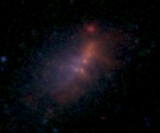
NGC 2915
Encyclopedia
NGC 2915 is a blue dwarf
galaxy
located 12 million light-year
s away, right on the edge of the Local Group
. It is remarkable in that the optical galaxy corresponds to the core of a much larger spiral galaxy
traced by radio observation
of neutral hydrogen
http://wwwatnf.atnf.csiro.au/people/bkoribal/ngc2915/n2915.html.
The galaxy has a short central bar, much like the Milky Way
and very extended spiral arms.
The reason for the spiral arms and majority of the galaxy's disk to be still neutral hydrogen (as opposed to have formed star
s) is not well-understood but is thought to be related to the galaxy's isolation, in that it has no nearby satellite galaxies
and no nearby major galaxies to force star formation
.
Blue compact dwarf galaxy
In astronomy, a blue compact dwarf galaxy is a small galaxy which contains large clusters of young, hot, massive stars. These stars cause the galaxy to appear blue in color. Since they exist mostly in clusters, blue compact dwarf galaxies don't have an exact uniform shape...
galaxy
Galaxy
A galaxy is a massive, gravitationally bound system that consists of stars and stellar remnants, an interstellar medium of gas and dust, and an important but poorly understood component tentatively dubbed dark matter. The word galaxy is derived from the Greek galaxias , literally "milky", a...
located 12 million light-year
Light-year
A light-year, also light year or lightyear is a unit of length, equal to just under 10 trillion kilometres...
s away, right on the edge of the Local Group
Local Group
The Local Group is the group of galaxies that includes Earth's galaxy, the Milky Way. The group comprises more than 30 galaxies , with its gravitational center located somewhere between the Milky Way and the Andromeda Galaxy...
. It is remarkable in that the optical galaxy corresponds to the core of a much larger spiral galaxy
Spiral galaxy
A spiral galaxy is a certain kind of galaxy originally described by Edwin Hubble in his 1936 work The Realm of the Nebulae and, as such, forms part of the Hubble sequence. Spiral galaxies consist of a flat, rotating disk containing stars, gas and dust, and a central concentration of stars known as...
traced by radio observation
Radio astronomy
Radio astronomy is a subfield of astronomy that studies celestial objects at radio frequencies. The initial detection of radio waves from an astronomical object was made in the 1930s, when Karl Jansky observed radiation coming from the Milky Way. Subsequent observations have identified a number of...
of neutral hydrogen
Hydrogen
Hydrogen is the chemical element with atomic number 1. It is represented by the symbol H. With an average atomic weight of , hydrogen is the lightest and most abundant chemical element, constituting roughly 75% of the Universe's chemical elemental mass. Stars in the main sequence are mainly...
http://wwwatnf.atnf.csiro.au/people/bkoribal/ngc2915/n2915.html.
The galaxy has a short central bar, much like the Milky Way
Milky Way
The Milky Way is the galaxy that contains the Solar System. This name derives from its appearance as a dim un-resolved "milky" glowing band arching across the night sky...
and very extended spiral arms.
The reason for the spiral arms and majority of the galaxy's disk to be still neutral hydrogen (as opposed to have formed star
Star
A star is a massive, luminous sphere of plasma held together by gravity. At the end of its lifetime, a star can also contain a proportion of degenerate matter. The nearest star to Earth is the Sun, which is the source of most of the energy on Earth...
s) is not well-understood but is thought to be related to the galaxy's isolation, in that it has no nearby satellite galaxies
Satellite galaxy
A satellite galaxy orbits a larger galaxy due to gravitational attraction. Although a galaxy is made of a large number of objects which are not connected to each other, it has a center of mass, which represents a weighted average of the positions of each component object...
and no nearby major galaxies to force star formation
Star formation
Star formation is the process by which dense parts of molecular clouds collapse into a ball of plasma to form a star. As a branch of astronomy star formation includes the study of the interstellar medium and giant molecular clouds as precursors to the star formation process and the study of young...
.

